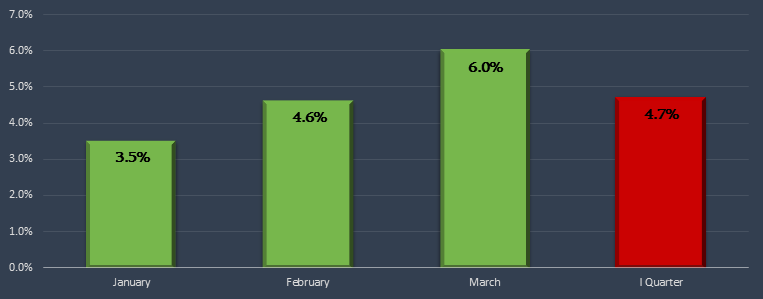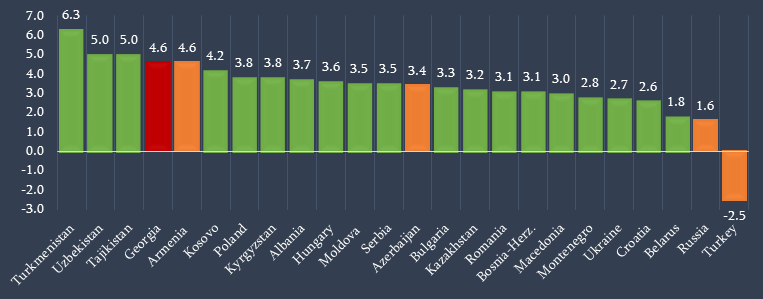Resume: In accordance with the National Statistics Office of Georgia’s preliminary assessment, the real economic growth rate (GDP) in March 2019 was 6% as compared to the same period of the previous year whilst the annual real growth in the first quarter of 2019 was 4.7%.
In regard to the yearly estimate of the economic growth rate, of note is that Georgia’s estimated economic growth rate was indeed 5% in accordance with the World Bank’s report published in January 2019. However, the estimated economic growth rate was slashed to 4.6% in a subsequent report. In accordance with the International Monetary Fund’s estimates, Georgia’s economic growth rate is also 4.6%.
Georgia’s economic growth rate in the region should be analysed vis-à-vis the 23 countries of Europe and Central Asia’s non-high income region. Of the Europe and Central Asia region’s (non-high income) countries, as well as those of CIS countries, the highest estimated economic growth rate for 2019 is in Turkmenistan with 6.3%. Tajikistan and Uzbekistan are ranked in the second and third positions, each with 5% economic growth rates. Georgia, with its 4.6% estimated economic growth rate, is in the fourth and fifth positions together with Armenia. It can be said that Georgia’s economic growth rate is indeed one of the highest in the region although this performance cannot be satisfactory for a developing economy.
In regard to the second part of the statement (Georgia’s economic growth rate more than twice exceeds the economic growth rates of our neighbours), Georgia and Armenia have the exact same estimated economic growth rates whilst Georgia’s economic growth rate is 1.3 times higher as compared to Azerbaijan’s economic growth rate and not twice as high. Georgia’s estimated economic growth rate is 2.8 times higher as compared to Russia’s estimated economic growth rate whilst negative economic growth is expected in the case of Turkey.
Analysis
The Minister of Economy and Sustainable Development of Georgia, Natia Turnava, stated: “We had a 6% economic growth rate in March and with an estimated annual 5%, we are a high economic growth country in the whole region. Our economic growth rate more than twice exceeds the economic growth rates of our neighbours.”
In accordance with the National Statistics Office of Georgia’s preliminary assessment, the real economic growth rate (GDP) in March 2019 was 6% as compared to the same period of the previous year whilst the annual real growth in the first quarter of 2019 was 4.7%.
Graph 1: Preliminary Assessment of the Economic Growth Rate (2019 as Compared to the Same Period of the Previous Year)

Source: National Statistics Office of Georgia
In March 2019, growth was perceptible in trade, transport, real estate operations and other services as compared to the same period of the previous year. In addition, growth was registered in utilities and social and personal services. The construction field experienced a decline.
Natia Turnava’s statement in regard to the economic growth rate in March is true. In regard to annual growth estimates, of note is that Georgia’s estimated economic growth rate was indeed 5%in accordance with the World Bank’s report published in January 2019. However, the estimated economic growth rate was slashed to 4.6% in a subsequent report. In accordance with the International Monetary Fund’s estimates, Georgia’s economic growth rate is also 4.6%. Deterioration in external economic factors; that is, a decreased foreign demand, on the one hand, and the negative impact of lending regulations, on the other hand, were behind the decision to cut the estimated economic growth rates. See FactCheck’s research on this topic.
Whilst comparing Georgia’s GDP growth to other economies, it is important to clearly define the region where Georgia belongs in that this is relevant for comparison. In a narrow definition of a region, we can assume Georgia’s neighbourhood (Armenia, Azerbaijan, Turkey and Russia). The International Monetary Fund thinks of Georgia as a CIS member country (even though Georgia is no longer a CIS-member country). However, in accordance with the World Bank’s country groups, Georgia is in the Europe and Central Asia country region (excluding the high-income nations). In turn, CIS member countries also are part of this group with the economies of this region’s countries having more or less similar characteristics. In addition, the countries of this group have close trade relations with each other. Therefore, Georgia’s economic growth vis-à-vis the region should be considered against Europe and Central Asia’s 24 non-high income countries. It is also possible to make comparisons with CIS member countries given that this is something the International Monetary Fund does.
Graph 2: Estimated Economic Growth Rate for 2019 (%)[1]

Source: International Monetary Fund
Of Europe and Central Asia (without high-income) region countries as well as the CIS countries, Turkmenistan has the highest estimated economic growth rate with 6.3%. Turkmenistan is followed by Tajikistan and Uzbekistan, each with a 5% estimated economic growth rate. Georgia, together with Armenia, shares the fourth and fifth positions with a 4.6% estimated economic growth rate. It can be said that Georgia’s economic growth rate is indeed one of the highest in the region. However, when it comes to the neighbours, Georgia and Armenia have the exact same estimated economic growth rates whilst Georgia’s economic growth rate is 1.3 times higher as compared to Azerbaijan’s economic growth rate and not twice as high. Therefore, Natia Turnava’s statement contains an inaccuracy. Georgia’s estimated economic growth rate is 2.8 times higher as compared to Russia’s estimated economic growth rate whilst negative economic growth is expected in the case of Turkey.
















